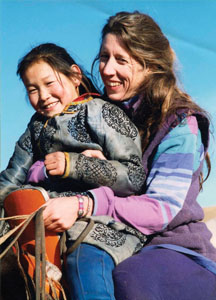Straight Talk About Vodou
 It’s difficult to decide which is more intriguing: that Assistant Professor of Religion Elizabeth McAlister keeps a couple of zombies in her office, or the idea that she might not have the zombies (or the office at Wesleyan, for that matter) if it weren’t for Phil Donahue. Both facts can be easily explained, but perhaps the best place to start is at a Haitian cultural center in Rockland County, N.Y., in the 1970s.
It’s difficult to decide which is more intriguing: that Assistant Professor of Religion Elizabeth McAlister keeps a couple of zombies in her office, or the idea that she might not have the zombies (or the office at Wesleyan, for that matter) if it weren’t for Phil Donahue. Both facts can be easily explained, but perhaps the best place to start is at a Haitian cultural center in Rockland County, N.Y., in the 1970s.
The center was created by McAlister’s father, a high school French and Spanish teacher and long-time civil rights activist who wanted to give the influx of Haitian immigrants a safe place to congregate and learn ways to acclimate better to their new home. Befriending some of the new Haitians in the area, “Liza” and several friends began studying Haitian drumming with a master drummer—a “priest of the drum” in Afro-Haitian religion.
“Then one night he announced, quite matter-of-factly, that we would be going to a Vodou ceremony to play for a prayer service,” she says.
“It turned out to be a whole night of ritual drumming, prayer songs, and dance,” she says. “It was fascinating.”
At the time, McAlister was majoring in anthropology at Vassar, and the ceremony provided a crystallization of sorts.
“Vodou is a very complicated religious system,” she says. “It draws from Roman Catholicism and West African religions, and it’s been changed—Creolized—through the centuries by African slaves and their descendents in Haiti.
“I realized that Vodou was also a new religion in the United States, and that it had really been misrepresented in the media and especially in Hollywood. This misrepresentation was detrimental to new Haitian immigrants, like the people I knew through the Haitian community center. Few people had studied and written about the real practice of Vodou as a religion. It quickly became my research passion.”
But this passion wasn’t quite enough to propel McAlister into academia immediately after earning her undergraduate degree. Instead she chose journalism and took a job at Esquire. Soon after, she penned an article on Vodou for a sister magazine called New York Woman. Very quickly, the calls started pouring in.
“I got calls from every TV and radio talk show out there asking me to come on and talk about Vodou,” she says.
In the end she decided to pass on Oprah, Geraldo, and the others and appear on Phil Donahue’s nationally syndicated television show. She made the decision in part because, at the time, Donahue was the most established and respected talk show host in the country. But more important to McAlister, his show presented itself to her as the most principled of the lot.
But when the lights went up, and the cameras rolled, Donahue opened by turning to McAlister and asking: “Elizabeth, what did your parents say when you told them you joined a Vodou cult?”
“I was ready for a serious discussion, and all Donahue wanted to do was sensationalize the issue. He basically said, “What’s a nice white Vassar girl like you doing with all these Haitians?’ It was racist and sexist. His take was the same as most American popular culture on Vodou—that it is irrational, and even evil. It was disappointing.”
But it was also motivating. McAlister realized that if she wanted to educate people about African-based religions and be taken seriously, she would have to be more than a journalist. She needed to undertake a thorough, scholarly study in order to acquire the expertise she would need to teach others about rich African American cultures.
Along with earning master’s and doctoral degrees at Yale and learning Haitian Creole, this quest involved field studies of Haitian communities in the United States and several trips to Haiti, where she acquired the zombies she keeps in her office.
The zombies were a gift from a bòkò: loosely translated, a “sorcerer.” While McAlister was interviewing him in Port-au-Prince, she admired a bottle decorated with, among other things, scissors, pins, mirrors, and fabric. The man offered to make one for her. McAlister agreed, thinking she had just commissioned her first piece of Haitian art. But then the bòkò asked, “Would you like me to put good luck in?” McAlister learned that this good luck would come from capturing spirits of the recently dead and containing them in the bottle.
While part of a person’s soul goes on to the afterlife, accoding to Vodou, another part of the soul lingers at his or her gravesite. A bòkò can capture this lingering soul and put it to work for someone who is alive.
“Don’t worry,” says McAlister, smiling. “After a certain time, the whole soul is thought to go to God!”
The bòkò allowed McAlister to witness the ceremony. He stood in front of his small altar, singing along to the soundtrack of ritual music playing on his shiny new Panasonic cassette deck. After a few songs, he shaved small bits from two human skulls, and put the bone fragments into the bottle, along with the ashes from an American dollar, leaves, perfume and liquor. The zombies comprised the bones and prayers together, McAlister realized later.
Adding the American dollar was a symbolic command to bring her money. The leaves were a signal of health, the perfume was to attract love, and the liquor would preserve the assemblage and give it mystical “heat.” All the ingredients together were instructions to the captured spirits, for what specific kinds of work they were commanded to do. Even the outside of the bottle was a set of instructions: the scissors were to stab anyone coming to harm her, the mirrors would also deflect harm. But the cloth that dressed the bottle was McAlister’s first clue—reflecting later, back at Yale—that the bottle was a relative of Kongo religious thought. The black, red and white that covered the bottle were exactly the colors that the Kongo used (and use) in their religious symbolism.
“I found a clear historical link between contemporary Haitian magic and certain ritual practices of the Kongo of Central Africa. The key elements used in making this twentieth-century Haitian object were consistent with fifteenth-century Kongo ‘spirit-medicine’—what the Portuguese colonizers called fetico, or fetish.”
She points to her bookshelf, to the bottle. “I traced, through the religious material culture of contemporary Haitians, a link to the religious worldview of the Kongo Kingdom. Many Europeans have assumed that Africans in the Americas have no lasting culture traceable to Africa. This one little bottle proves that African Americans have a particular and identifiable rich and creative cultural history that has lasted—in changed forms—for centuries in the Atlantic world. And it proves that we can trace that history using creative scholarly methods.”
McAlister has recently published a book, Rara! Vodou, Power, and Performance in Haiti and Its Diaspora, that explores Rara, an annual festival the religion holds to coincide with the Catholic celebration of Lent. The Haitian poor use the festival as one of the last bastions of uncensored speech in a country where a “political economy of brutality” leaves the majority of the country totally disenfranchised. Haitian immigrants also perform Rara in New York City parks during the summer, creating a “roots culture” which, like Jamaican Rastafarians, lets them express a particularly Caribbean Black ethnicity.
McAlister hopes that through the kinds of careful scholarship she—and others—do on Vodou, the demonized images of the religion promoted by the popular media and movies will diminish.
“Vodou is one of the foundations of Haitian culture,” she says. “Historically, it is wrapped up in politics, medicine, justice, gender, and now transnational migration and other facts of Haitians’ lives. We need to treat it as we treat other religions: critically, but with basic respect. We need to talk less about what it isn’t and look more at what it is.”
Phil Donahue, are you listening?
Download a PDF of the complete article HERE


